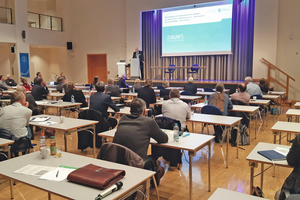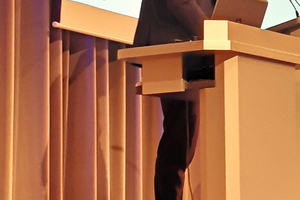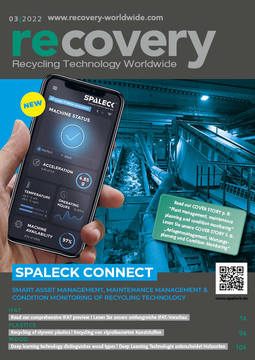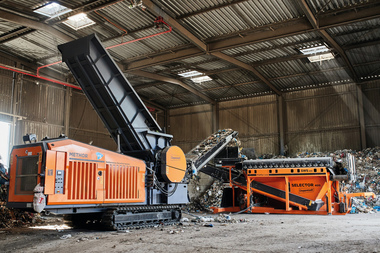Conference of the FIRE Interessengemeinschaft der Recyclingwirtschaft e. V. in Freiberg/Saxony
The choice of date for the Freiberg Recycling Conference on October 12, 2021 proved to be a stroke of luck, because despite the still ongoing Corona pandemic, it could be held as an attendance event. More than 50 participants from authorities, companies, engineering firms and universities took the opportunity to learn about the development of the landfill situation, primarily in Saxony, and about new recycling options for waste. Unfortunately, representatives from political bodies did not take up the invitation. Although the focus of the event was on Saxony, the contributions are likely to be of general interest to the industry, so they are reported here.
In his introductory speech, the managing director of FIRE e.V. Dipl.-Ing. Stefan Grunig emphasized „that we are living in a time in which aspiration and reality are increasingly diverging“ and cited the zero-waste movement and recycling-friendly design as examples of this in the waste sector. The view was more than reinforced in the course of the event. He stated that not all waste is fully recyclable and even high-quality recycled products are not or only partially accepted by the market, so landfill options will continue to be necessary. Waste streams continue to increase, not least due to the rapid growth of online retailing with its enormous volumes of outer packaging and filling material. Increasing waste volumes also invariably lead to greater input for incineration plants. Meanwhile, it is mainly environmental associations that still prefer the zero-waste route and do not realistically assess incineration capacities or landfills in view of the new legal situation (MantelV). Mr. Grunig dealt very critically with some legal regulations and their practical implementation, such as § 28 KrWG- product responsibility or the separate collection of biowaste, which has been legally anchored for many years, but also the new regulations in the EBV with stricter limits and the resulting reduction of disposal options (landfill construction materials). A wide field, which Mr. Grunig underlined with many examples and misjudgements of the past and thus – after thanking the speakers, sponsors and participants – opened the conference.
Impulse lectures
Moderated by Prof. Dr. Cristina Dornack, TU Dresden, three presentations dealt with topics of general interest:
The update of the waste management plan of the Free State of Saxony (Dr.-Ing. Erik Nowak SMEKUL Dresden, Department of Materials Management)
Utilization of non-mining waste in Saxon opencast mines in the 21st century – a sustainable green deal (Ralph Weidner, SMWA, Department of Mining and Resources)
Evaluation of the use of non-mining waste for the recultivation of opencast pits in lignite mining (Dr.-Ing. Karsten Menschner, CDM Smith, Leipzig)
All three presentations showed, on the one hand, the critical approach to the adopted MantelV, which still has many shortcomings, and on the other hand, euphoric goals, for example, still the promotion of zero-waste concepts of the ÖRE (public waste management authorities) through waste avoidance and preparation for recycling. However, enforcing product design for recycling is seen as unlikely to be enforceable in the global economy. Landfill capacities are judged to be sufficient, which was strongly questioned in the discussion under the aspect of the new legal situation. In addition to the usual vague intentions to promote higher-quality recycling and the use of recyclates, to develop and use appropriate capacities for waste for disposal in line with demand, it was stated that disposal within Saxony is guaranteed in the long term according to the principle of self-sufficiency and proximity.
In the contribution of Mr. Weidner, the discrepancy between available material quantities (soil and dredged material for backfilling, concrete, bricks, ceramics for use in mining and operational purposes) and void volumes was substantiated with figures. The latter is exceptionally large as things stand today, and thus recovery capacities are still available in the long term (≥ 42 a). In contrast, the volume recycled annually is actually too small to meet reclamation obligations in a timely manner. „In addition, as a result of ever-increasing legal requirements and tightening restrictions on waste recovery in open pits, this effect is expected to increase.“
Dr. Meschner presented a complex evaluation method, with which the suitability and intended use of the approved non-mining wastes was proven in an environmentally compatible manner, especially for the protected resource of water, with regard to achieving the reclamation goal for recultivation. This evaluation method can also be adapted to similar questions for the environmentally compatible emplacement of foreign materials for the reclamation/reclamation of former opencast mines.
Assessment of the landfill situation
In this block of lectures, under the direction of the moderator Prof. Alexandros Charitos, TU BA Freiberg, three speakers had their say, who presented the topic from the point of view of a waste producer, the private waste disposal industry and an ÖRE.
The managing director of Becker Umweltdienste GmbH, Gerold Münster, spoke about the justification of need in the construction of landfills and stated that this does not restrict entrepreneurial initiative. His reasons for this: the planning approval is an orderly procedure; the interpretation of the case law provides clear guard rails that limit an excessive justification of need; the presentation of the need represents an official hurdle that can be overcome; the decision on the justification of need is subject to judicial review with the possibility of challenging the official decision.
GF André Albrecht, ZAW Zweckverband Abfallwirtschaft Westsachsen came to the conclusion that the planning, construction and operation of a state-owned landfill of the Free State of Saxony or the Central German states of SN, SA, TH based on the model of the Ihlenberg landfill (state landfill MV) with the participation of ÖRE and the private sector could be a solution for the future disposal of non-recyclable mineral waste (DK I and DK II).
Very impressively, authorized signatory Knut Seifert, AMAND Umwelttechnik Lockwitz GmbH & Co. KG, shared his experience on the subject of „Waste-based mineral building materials – theory and reality in their use“. The current situation with regard to building material recycling has hardly changed in recent years, despite manifold calls from politicians and the government, so that the share of recycled building materials in the total volume of building materials is still only 11 – 13 %, according to the speaker even only 5 %. At the same time, the sale of clean concrete- or brick-based chippings is generally not a problem. However, their production always results in a considerable proportion of sand (up to about 4 mm), which is hardly marketable today, about 40% for concrete and about 50 – 60 % for bricks. Also not marketable are chippings produced from mixed building rubble, which are mainly „utilized“ in surface pits. The speaker went into detail on the reasons for the hindrance and rejection of the use of RC building materials (no public tenders in line with requirements, although obliged to do so; mistrust and no acceptance of and against everything that was once waste, with the public making veritable contributions to this; insufficient application of the laws already in place, such as § 10 Sächs. KrWBoSchG/ § 45 KrWG). Mr. Seifert also critically discussed the new EBV and criticized above all the state opening clause contained therein, which again allows a deviation from the federal regulations finally fixed with the adopted MantelV. His demand: Creation of clear regulations, without backdoors regarding communication and enforcement for authorities as well as producers and users.
The goal and aspiration of all parties involved should be „to define all RC products/replacement building materials as equivalent building materials with a uniform language in order to finally step out of the negative corner of the term waste.“
The next three contributions dealt with concrete recycling options for mineral waste. Dipl.-Ing. Elke Radke, BVDG Düsseldorf, described the German foundries, in which 90 % of the input consists of scrap, as perfect recycling plants with functioning material cycles. In her contribution, she explicitly addressed the question: „Is foundry sand worthless waste or valuable raw material?“ Today, 95 % is recycled. But even the remaining 5 % (2.2 million tons) is recycled externally to 53 % in landfills. The goal is a qualitatively higher recycling, but this is strongly questioned by new EBV with its stricter regulations. Decreasing landfill capacities and longer distances also have an effect. Whether bioleaching can be a potential solution is currently being investigated, but it undoubtedly involves additional costs.
Dipl.-Ing. Weißpflog, SRW metalfloat GmbH Espenhain, reported on „Problems of the disposal of metal processing residues“, focusing in particular on the shredder residues of end-of-life vehicle recycling. Problematic materials are the high calorific value light fraction (SLF), but also the heavy fraction (SSF) with about 30 000 and 70 000 t/a, respectively, as well as the mineral residues with 60 000 t/a. For the latter, DK II and DK IV landfills are required. Based on a study on landfill capacities, the speaker pointed out the precarious situation for the disposal of these problematic materials due to the finite landfill space available and the increasing disposal costs. Further difficulties are likely to arise from the increasing use of carbon fiber-reinforced plastics in the automotive industry, which are also problem materials.
Examples of new recycling options
Under this topic, Dr. -Ing. Axel Zentner, TU Dresden, outlined the challenges for a functioning recycling economy posed by innovative materials in the construction industry. He also dealt with the effects of the ManteV, which, in addition to the positive side – enabling a uniform evaluation – brings with it a number of disadvantages, such as: Reduction of recyclate quantities, correspondingly an increase in the quantities to be landfilled, thus an additional shortage of landfill volume, an additional land use, increased transport expenses, a reduction of the recycling and substitution quota as well as a shortage of raw materials. As part of the strategies developed at the TU Dresden to reduce the consumption of raw materials, two projects were presented:
Integrated concept for mineral waste and land management for sustainable development of urban-land use relationships (BMBF joint project), duration: 02/2020 -01/2023 (+2 years)
We recycle fibers (also a BMBF joint project) within the funding measure „"change through innovation in the region“, in which carbon fibers and carbon concrete and their recyclability are dealt with
Dr.-Ing. Marc Lüpfert, TU BA Freiberg, demonstrated a good example of how a residual material from glass recycling can be used to make lightweight construction materials. In Germany, about 60 000 t/a of residual materials from glass recycling (ceramics, stones porcelain = fraction KSP) are produced. Through laboratory-scale tests and subsequent up-scaling to industrial scale, it has been demonstrated that it is possible to process the KSP fraction in such a way that expanded glass can be produced. Additives can be used to further improve the properties. It is technically possible to replace expanded clay with expanded glass in lightweight concrete. Among other things, better thermal insulation can be achieved by using lightweight concrete with expanded glass with the same strength. Another conceivable application is in fire protection.
The conference was concluded by the highly interesting and exciting contribution of Dr.-Ing. Hans-Georg Jäckel, TU BA Freiberg, on „Waste from the energy and mobility turnaround – future recycling products with critical content for recycling and disposal“. It would be a lecture for the politically responsible people in our country to come down to earth, even if some data were extrapolated and assumptions inevitably flow into such considerations. Using a wide range of figures, Dr. Jäckel showed very impressively what it means to achieve the ambitious goal of greenhouse gas neutrality in Germany by 2050, if possible in 2038, through the envisaged energy and mobility turnaround as well as the turnaround in the building sector. In addition to the presentation of the new wind energy and photovoltaic plants to be installed, the speaker also dealt with the waste quantities and qualities resulting from the dismantling and demolition of the old plants (NPP, BKW, SKW), the recycling of which, at least in the case of NPP waste or landfilling, is encountering the greatest acceptance problems. He also focused on new wastes from building materials and mobility, including carbon concrete and Li-ion batteries, and the recycling challenges associated with them, as numerous new material composites and chemistries with extremely energy-intensive recycling techniques are required. His conclusion: the conception of the energy transition has so far been done without taking recycling and disposal costs into account, but it is urgently needed, otherwise CO2 savings seem illusory and are unlikely to be achievable in the face of energy shortages.
As a summary of the event, it can be stated that the contributions repeatedly showed that we are facing an industrial turnaround, for which it is not only necessary to establish legal framework conditions, but equally to conduct research and development in order to find economically viable solutions and not to end up in wishful thinking.
The next event is scheduled for 2023.










